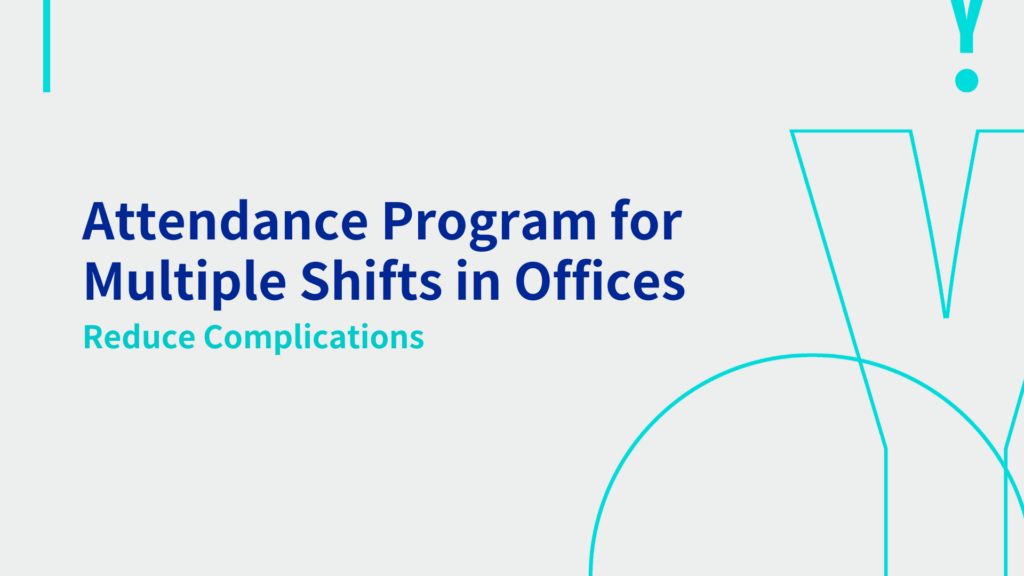
Tracking employee attendance sounds simple, but businesses operating with multiple shifts quickly discover it is anything but straightforward. Employees rotate between day, evening, and night schedules, making consistent recordkeeping extremely challenging.
In the absence of an efficient attendance program, HR managers often spend countless hours verifying timesheets. They have to calculate overtime and reconcile discrepancies caused by shift overlaps.
Here, mistakes not only delay payroll but also create dissatisfaction among employees. Furthermore, compliance with labor laws becomes harder when different shifts include unique allowances, overtime structures, and legal limits. Relying on outdated manual methods leads to frequent errors, missed details, and even penalties.
Therefore, companies must consider structured attendance management programs designed for shift-based operations. These systems reduce manual effort, eliminate mistakes, and foster trust among employees.
In the following sections, we’ll explore why modern attendance solutions are essential and how they transform multi-shift management into a smooth, accurate, and compliant process.
- Why Multi-Shift Attendance Is More Complex?
- Common Challenges Businesses Face in Attendance Tracking
- Why Businesses Need An Attendance Management Program?
- Key Benefits of Using Multi-Shift Attendance Software
- Essential Features Businesses Should Look For
- Best Practices for Implementing Multi-Shift Attendance
- A Real-World Example of Attendance Management in Action
- Transitioning to An Attendance Management Program
- The Future of Attendance Tracking for Businesses
- Outsourcing Attendance Management As A Strategic Choice
- End Note
Why Multi-Shift Attendance Is More Complex?
Multiple Shifts Bring Irregular Work Patterns
Unlike single-shift offices, multi-shift organizations operate around the clock. Therefore, this creates irregular work patterns that require accurate and dynamic tracking.
Employees may frequently switch from day to night or rotate weekly, making it difficult to maintain consistent records.
Overtime And Shift Allowances Add More Complexity
Attendance management is not limited to simply logging hours. For night shifts, employees may be entitled to additional allowances.
Weekend or holiday shifts require overtime calculations that must align with labor laws. Without structured systems or cloud HR software, handling these complexities becomes frustrating and error-prone.
Compliance Risks Multiply with Shifts
Every business must comply with local labor regulations, but compliance grows tougher with multiple shifts.
Laws governing maximum working hours, mandatory rest breaks, and overtime vary across jurisdictions. Manual systems often fail to ensure accuracy, exposing businesses to fines and disputes.
Common Challenges Businesses Face in Attendance Tracking
- Inaccurate Monitoring of Hours
When employees work irregular shifts, manual tracking struggles to capture precise entry and exit times. Small errors eventually create major payroll issues.
- Difficulty Managing Shift Swaps
Employees frequently swap shifts at the last moment, and without an automated system, managers lose track of actual hours worked.
- Growing Administrative Burden
As businesses expand, tracking attendance for hundreds of employees across shifts consumes enormous amounts of administrative time. HR teams spend less time on strategy and more on corrections.
- Lack of Transparency for Employees
Employees often complain about discrepancies because they lack access to real-time records. Hence, this damages trust and creates unnecessary disputes.
Why Businesses Need An Attendance Management Program?
Automation Reduces Human Error
Attendance management programs eliminate guesswork by automatically recording employee data. With automation through a modern attendance program, errors caused by manual tracking are reduced significantly.
Compliance Becomes Easier
Systems designed for multiple shifts integrate labor law rules, thus ensuring companies follow regulations on overtime, night allowances, and working hours.
Transparency Builds Employee Trust
Modern programs offer employee self-service portals where individuals can view their attendance records, overtime, and shift histories without HR intervention.
Payroll Integration Creates Efficiency
When attendance directly integrates with payroll, businesses avoid mismatches and ensure timely salary disbursements. Employees feel valued, and HR saves time.
Key Benefits of Using Multi-Shift Attendance Software
Accurate & Consistent Records
Modern software guarantees accuracy by tracking every check-in and check-out in real time. This consistency removes disputes and prevents fraud.
Simplified Overtime And Allowance Calculations
Instead of manually calculating shift allowances or overtime pay, systems automatically apply rules, saving HR countless hours.
Better Absenteeism Management
With data-driven insights, businesses can track absenteeism trends across shifts, helping managers forecast workforce needs more effectively.
Reduced Operational Stress
By automating tedious processes, HR teams spend less time correcting errors and more time driving organizational growth and employee engagement.
Essential Features Businesses Should Look For
Integration with Shift Scheduling
Programs must synchronize directly with shift schedules. So, whenever managers update rosters, attendance automatically reflects those changes. Here, a cloud HR software can help.
Biometric And Digital Check-In Options
Reliable identification through biometric systems or secure digital platforms eliminates buddy punching and ensures accuracy.
Automated Compliance Monitoring
Regulations differ by location, and automated compliance features ensure businesses never overlook legal requirements.
Cloud-Based Accessibility
Modern businesses require flexibility. Cloud solutions allow HR and managers to access data anytime, anywhere, thus, ensuring continuous oversight.
Best Practices for Implementing Multi-Shift Attendance
- Prioritize Automation from The Start
Businesses should avoid relying on manual methods alongside digital systems. Full automation reduces dependency on human intervention.
- Train Managers And Staff Thoroughly
Introducing a new system requires careful training. Employees and managers must understand how to log attendance correctly and use self-service features.
- Conduct Routine Compliance Audits
Even with automation, regular audits guarantee that systems remain aligned with labor laws and organizational policies.
- Leverage Data Insights for Improvements
Analytics generated by attendance software reveal absenteeism trends, overtime usage, and productivity insights. Managers can use this information to optimize scheduling.
A Real-World Example of Attendance Management in Action
Imagine a business process outsourcing (BPO) company operating three shifts daily. Before automation, managers struggled with absenteeism tracking and overtime calculations. Employees frequently complained about missing hours on timesheets, leading to payroll disputes.
After implementing attendance software, check-ins became biometric, shifts automatically synced with payroll, and employees accessed their records anytime. Over three months, absenteeism dropped significantly, disputes decreased, and compliance audits were easier to pass.
Employee satisfaction rose, proving that accurate attendance directly impacts workforce morale.
Transitioning to An Attendance Management Program
- Assess Existing Systems First: Businesses must identify weak points in their current process, whether it is paper timesheets, spreadsheets, or outdated software.
- Choose A Program That Fits Shifts: The chosen system should be customizable for rotating, fixed, and overnight schedules. Scalability ensures it grows alongside the business.
- Conduct A Pilot Implementation: Instead of shifting everyone immediately, businesses should test the program with one department before organization-wide rollout.
- Encourage Feedback from Staff: Employee feedback helps managers fine-tune policies, ensuring smooth adoption and long-term success.
The Future of Attendance Tracking for Businesses
Technology continues to reshape attendance management. Artificial intelligence will soon predict absenteeism, allowing proactive scheduling adjustments. Machine learning will optimize overtime distribution, ensuring fairness across teams.
Cloud-based platforms will dominate, providing accessibility for remote and hybrid workforces. Ultimately, businesses adopting these innovations early will gain smoother operations, happier employees, and competitive advantages.
Outsourcing Attendance Management As A Strategic Choice
For businesses without the capacity to manage advanced systems, outsourcing offers a viable option. Professional service providers bring expertise, updated compliance knowledge, and advanced tools.
Therefore, outsourcing reduces risks, minimizes administrative burdens, and ensures accurate recordkeeping. Many organizations find it cost-effective, especially when operating across multiple locations and time zones.
So, if you integrate the best management for attendance, consult experts at YOOV.
End Note
Managing attendance across shifts does not need to be overwhelming for businesses. With the right program, companies can eliminate manual errors, ensure compliance, and increase transparency.
Employees gain trust when records remain accurate, and HR professionals gain freedom to focus on strategy. Whether businesses choose in-house for attendance programs or outsourced solutions, the goal remains the same—streamlined operations, happier employees, and stronger compliance.
Attendance management programs are not simply tools. They are investments that drive long-term growth and stability.
Connect with YOOV

WhatsApp:Click Here
Email:hello@yoov.com
Website:https://www.yoov.com/